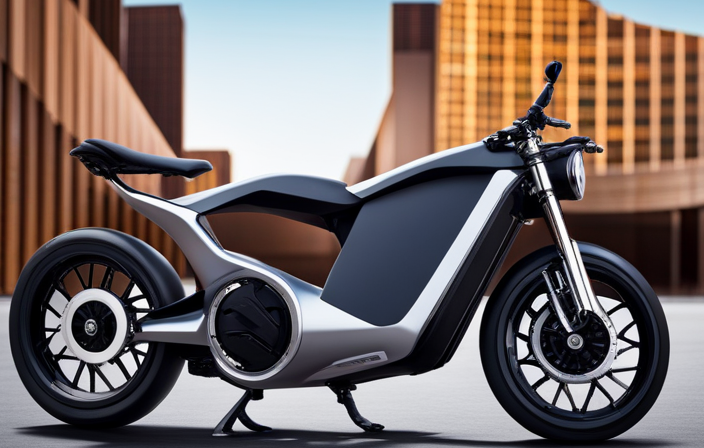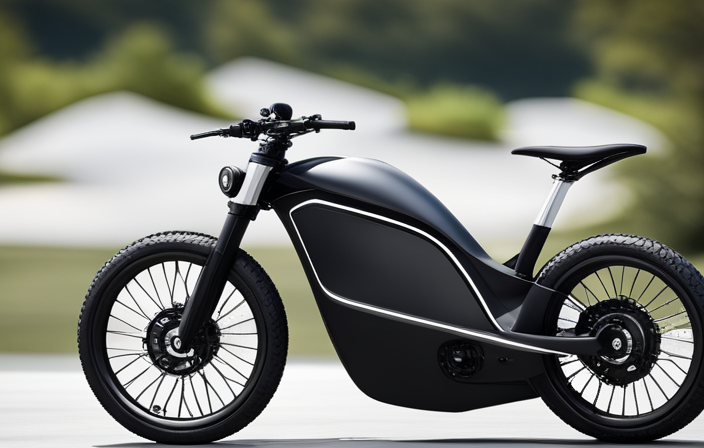If you’re looking to transform your standard bicycle into an electric powerhouse, you’re in the right spot.
In this guide, I’m going to show you exactly how to transform your bike into an eco-friendly electric machine using a lead-acid battery pack. Don’t worry if you’re not a tech wizard – I’ll break it down step by step, ensuring you have all the necessary materials and tools.
Get ready to embark on a thrilling journey of bike electrification!
Key Takeaways
- Choose the right battery size and type for your electric bike
- Properly install the battery by connecting it to the motor and controller and securely mounting it on your bike
- Regularly test and maintain the battery pack to ensure proper functionality and extend its lifespan
- Dispose of the lead-acid battery properly to minimize environmental impact and seek professional help if needed
Gather the Necessary Materials and Tools
First, you’ll need to gather all the materials and tools required for the electric bike battery pack. To ensure proper battery maintenance and maximize its lifespan, it’s essential to have the right equipment.
Start by getting a voltmeter to measure the battery’s voltage accurately. You’ll also need a battery charger that is compatible with lead-acid batteries. Look for a charger that offers multiple charging modes, such as trickle charging and fast charging, to accommodate different battery charging techniques.
Additionally, grab wire cutters and strippers to handle the battery connections effectively. Lastly, don’t forget to have a set of wrenches or pliers to tighten the battery terminals securely.
Now that you have all the necessary tools, let’s move on to choosing the right battery size and type.
Choose the Right Battery Size and Type
When it comes to choosing the right battery size and type for your electric bike, there are two key factors to consider: your riding needs and distance.
Understanding these factors will help you determine the appropriate battery capacity and range required for your specific usage.
Additionally, it is crucial to be aware of the pros and cons of lead-acid batteries, as they are a popular choice for electric bikes but come with their own set of advantages and disadvantages that need to be weighed carefully.
Consider Your Riding Needs and Distance
Before you start building your lead-acid battery pack electric bike, think about your riding needs and how far you’ll be traveling. This will help determine the right battery size and type for your bike.
Consider your riding frequency, as this will impact the battery’s lifespan and overall performance. If you plan to ride frequently, you may want to invest in a larger capacity battery to ensure longer rides without needing to recharge.
Additionally, think about the distance you’ll be traveling on each ride. If you’ll be covering longer distances, you might want to opt for a battery with a higher energy density.
When it comes to charging options, you can choose between standard charging and fast charging, depending on your needs and preferences. Understanding these factors will help you make an informed decision when selecting the battery for your electric bike.
Now, let’s delve into the pros and cons of lead-acid batteries.
Understand the Pros and Cons of Lead-Acid Batteries
Let’s now explore the advantages and disadvantages of using lead-acid batteries for your e-bike.
When it comes to environmental impact, lead-acid batteries have a significant drawback. They contain toxic materials, such as lead and sulfuric acid, which can harm the environment if not disposed of properly.
On the other hand, lead-acid batteries are cost-effective. They are relatively inexpensive compared to other battery types, making them a popular choice for budget-conscious riders.
When considering charging time, lead-acid batteries are relatively slow to charge. It can take several hours to fully charge a lead-acid battery pack, which may not be ideal for those who need quick turnaround times.
Additionally, the lifespan of lead-acid batteries is generally shorter compared to other battery technologies.
With these factors in mind, it’s important to weigh the pros and cons before making a decision for your e-bike.
As we move forward, let’s now prepare your bike for battery installation.
Prepare Your Bike for Battery Installation
Make sure you’ve disconnected the bike’s power source before installing the battery. Choosing the right battery for your electric bike is crucial to ensure optimal performance and longevity. Before installation, it is essential to ensure proper preparation and installation techniques. Here is a table summarizing the key steps for proper battery installation:
| Step | Description |
|---|---|
| 1 | Disconnect the bike’s power source |
| 2 | Choose the right battery based on voltage and capacity requirements |
| 3 | Ensure the battery is fully charged before installation |
| 4 | Remove any existing battery or components obstructing the installation |
| 5 | Securely fasten the battery to the bike’s frame |
Connect the Battery to the Motor and Controller
Now that my bike is ready for the battery installation, it’s time to connect the battery to the motor and controller. This step is crucial for powering up the electric bike and ensuring a smooth ride.
To do this, I will follow these steps:
- Locate the motor and controller on the bike frame.
- Identify the positive and negative terminals on both the battery pack and the motor/controller.
- Connect the positive terminal of the battery pack to the positive terminal of the motor/controller.
- Connect the negative terminal of the battery pack to the negative terminal of the motor/controller.
By following these steps, I can ensure a proper connection between the battery pack, motor, and controller. However, if I encounter any motor or controller issues, I will troubleshoot them before proceeding. This will help me address any potential problems and ensure that my electric bike operates efficiently and safely.
Now that the battery is connected, the next step is to securely mount the battery pack on my bike.
Securely Mount the Battery Pack on Your Bike
To securely mount the battery pack on your bike, start by locating the designated mounting area on the frame. This area is typically located on the downtube or the rear rack of the bike. Once you have identified the mounting area, you can choose from different mounting options to ensure battery security. Here are some common mounting options:
| Mounting Option | Description |
|---|---|
| Frame Mount | Attaches the battery pack directly to the bike frame using brackets or straps. This option provides a secure and stable attachment. |
| Rear Rack Mount | Mounts the battery pack on a rear rack specifically designed for electric bikes. This option is convenient and allows for easy removal of the battery when needed. |
| Bottle Cage Mount | Utilizes a bottle cage adapter to attach the battery pack to the bike frame. This option is ideal for bikes with limited frame space and provides a secure attachment. |
| Seatpost Mount | Utilizes a seatpost adapter to attach the battery pack to the seatpost of the bike. This option is easy to install and allows for height adjustment of the battery pack. |
Once you have chosen the appropriate mounting option, carefully follow the manufacturer’s instructions to securely attach the battery pack to your bike. This will ensure that the battery remains stable and protected during your rides.
Now, let’s move on to the next section and test the battery pack to ensure proper functionality.
Test the Battery Pack and Ensure Proper Functionality
Once you’ve securely mounted the battery pack on your bike, it’s important to test it and ensure that it is functioning properly. To do this, there are several testing methods and troubleshooting techniques you can utilize.
One of the most common methods is to use a voltmeter to measure the voltage of the battery pack. A fully charged lead-acid battery should have a voltage of around 12.6 volts. If the voltage is significantly lower, it may indicate a problem with the battery.
Additionally, you can test the battery pack by connecting it to the motor and checking if it provides enough power to propel the bike. If you encounter any issues during the testing process, troubleshooting techniques such as checking the connections, fuses, and wiring can help identify and resolve the problem.
Perform Regular Maintenance and Inspections
Regular maintenance and inspections are crucial to keep the battery pack in optimal condition. As an electric bike owner, it’s important to understand the importance of regular maintenance for your battery pack.
Here are some inspection tips to help you keep your battery pack running smoothly:
- Check the battery’s overall condition, looking for any signs of damage or corrosion.
- Inspect the battery terminals for loose connections or signs of rust.
- Clean the battery terminals using a mixture of baking soda and water to remove any built-up corrosion.
- Regularly check the battery’s voltage levels to ensure it’s operating within the recommended range.
By regularly performing these maintenance tasks, you can extend your battery’s lifespan and ensure it continues to provide reliable power for your electric bike.
Taking care of your battery pack is essential for maximizing its performance and longevity.
Now let’s move on to how you can further extend your battery’s lifespan with proper care.
Extend Your Battery’s Lifespan with Proper Care
Taking good care of your battery will help it last longer. Proper battery charging techniques and preventing battery degradation are essential for maximizing the lifespan of your battery. Here are some tips to ensure you are giving your battery the care it deserves:
| Charging Technique | Description | Benefits |
|---|---|---|
| Avoid Overcharging | Do not leave your battery connected to the charger for an extended period after it reaches full charge. | Reduces stress on the battery and prevents overcharging. |
| Charge at Optimal Temperature | Charge your battery within the recommended temperature range to avoid damage. | Enhances the battery’s performance and extends its lifespan. |
| Use the Right Charger | Always use the charger specifically designed for your battery. | Prevents overcharging, undercharging, and potential damage to the battery. |
Understand the Safety Precautions and Risks
Understanding the safety precautions and risks associated with battery care is crucial to ensure a safe and efficient experience. When handling batteries, it is important to follow these guidelines:
-
Always wear protective gloves and goggles to prevent contact with corrosive materials and to shield your eyes from any potential splashes or spills.
-
Keep batteries away from open flames or sparks, as they can cause explosions or fires due to their flammable nature.
-
Store batteries in a cool and dry area, away from direct sunlight or extreme temperatures, as excessive heat or cold can negatively affect their performance and lifespan.
-
Dispose of used batteries properly by following local regulations and guidelines, as they contain hazardous materials that can harm the environment if not handled correctly.
By adhering to these safety precautions and handling risks, you can ensure a safer battery care routine.
Now, let’s transition to the next section where we will troubleshoot common battery issues without skipping a beat.
Troubleshoot Common Battery Issues
Transition: Now that we understand the safety precautions and risks associated with lead-acid battery pack electric bikes, let’s delve into troubleshooting common battery issues. As an electric bike enthusiast, it is essential to be equipped with troubleshooting techniques and battery maintenance tips to ensure optimal performance and longevity of the battery pack. To assist you in this endeavor, I have compiled a table below with some common battery issues, their potential causes, and recommended solutions. By following these troubleshooting techniques and implementing proper battery maintenance tips, you can avoid unnecessary downtime and enjoy a seamless riding experience. Now, let’s explore additional upgrades and accessories to enhance our electric bike’s performance and functionality.
| Common Battery Issue | Potential Causes | Recommended Solutions |
|---|---|---|
| Low battery capacity | Frequent deep discharges | Charge the battery regularly and avoid deep discharges |
| Battery not charging | Faulty charger or charging port | Check charger and charging port for any damage and replace if necessary |
| Battery overheating | High ambient temperature or excessive current draw | Allow the battery to cool down and reduce the load on it |
Transition: With our battery issues resolved, let’s now explore additional upgrades and accessories to further enhance our electric bike’s performance and functionality.
Explore Additional Upgrades and Accessories
To enhance your riding experience, consider adding upgrades and accessories that can boost the performance and functionality of your electric bike.
There are a variety of electric bike accessories available in the market that can enhance your riding experience. One popular accessory is the electric bike conversion kit, which allows you to convert your regular bike into an electric one. This kit usually includes a motor, battery, and controller.
Another popular accessory is the electric bike throttle, which provides you with easy control over the speed of your bike.
Additionally, performance upgrades such as a high-capacity battery or a more powerful motor can greatly improve the performance of your electric bike.
Enjoy Your Eco-Friendly Electric Bike
You can have a great time riding your eco-friendly e-bike. Here are a few tips to help you fully enjoy your electric bike:
-
Ensure proper electric bike maintenance:
-
Regularly clean your e-bike to prevent dirt and debris buildup, especially around the battery and electrical components.
-
Check the tire pressure and adjust it according to the manufacturer’s recommendations for optimal performance and efficiency.
-
Keep the chain lubricated to reduce friction and extend its lifespan.
-
Embrace the benefits of electric bikes:
-
Experience a smooth and effortless ride, thanks to the electric motor assistance.
-
Enjoy the convenience of commuting without breaking a sweat, especially on uphill climbs.
-
Reduce your carbon footprint by choosing an eco-friendly mode of transportation.
Stay Informed and Up to Date with Battery Technology
Stay up to date with the latest advancements in battery technology to ensure optimal performance and efficiency of your e-bike. Battery advancements have had a significant impact on transportation, especially in the electric bike industry.
With new breakthroughs in battery technology, e-bikes are becoming more powerful, allowing for longer rides and faster speeds. Lithium-ion batteries, for example, have revolutionized the industry with their high energy density and lightweight design. These batteries provide a longer range and shorter charging times compared to traditional lead-acid batteries.
Additionally, advancements in battery management systems have improved safety and reliability. It is crucial to stay informed about these advancements to make informed decisions when purchasing or upgrading your e-bike. By staying up to date, you can take advantage of the latest battery technologies and enjoy a more efficient and enjoyable riding experience.
As we ensure optimal performance by staying up to date with battery advancements, it is equally important to dispose of old batteries properly and responsibly.
Dispose of Old Batteries Properly and Responsibly
Properly disposing of old batteries is essential for environmental safety and preventing potential hazards. When it comes to battery disposal, there are a few important steps to follow:
-
Dispose Responsibly: It is crucial to dispose of batteries responsibly to minimize their impact on the environment. This means not throwing them in the regular trash or incinerating them.
-
Battery Recycling: Recycling is the preferred method for disposing of batteries. Many recycling centers and retailers offer battery recycling programs where you can drop off your old batteries for proper handling.
-
Proper Battery Disposal: If recycling is not available in your area, it is important to follow local regulations for proper battery disposal. This may involve taking them to designated collection sites or contacting your local waste management facility for guidance.
-
Environmental Impact: Improper battery disposal can have severe environmental consequences. Batteries contain harmful chemicals and metals that can contaminate soil and water sources if not disposed of correctly.
It is crucial to dispose of old batteries properly and responsibly to protect the environment and prevent potential hazards. However, if you are unsure about the proper disposal methods or have a large quantity of batteries to dispose of, it is recommended to seek professional help to ensure the safe handling and recycling of the batteries.
Seek Professional Help if Needed
If unsure about the proper disposal methods, it’s recommended to seek professional help for the safe handling and recycling of old batteries. Seeking assistance from experts ensures that the batteries are disposed of properly, minimizing the negative impact on the environment.
When it comes to lead-acid battery packs for electric bikes, troubleshooting tips can also be sought from professionals. They have the technical knowledge and experience to diagnose and resolve any issues that may arise with the battery pack. From identifying faulty connections to determining if the battery needs to be replaced, professionals can provide precise guidance.
Their expertise ensures that the battery pack functions optimally, extending its lifespan and maximizing the performance of the electric bike. So, don’t hesitate to reach out for professional assistance when needed.
Frequently Asked Questions
How do I choose the right battery size and type for my electric bike?
To choose the right battery size and type for your electric bike, consider factors such as desired range, weight, and budget. Research battery maintenance and charging techniques to ensure optimal performance and longevity.
What are some common battery issues that I might encounter with my electric bike?
Battery issues are like roadblocks on a thrilling ride. To diagnose common battery troubleshooting, observe for signs of reduced range, slow charging, or sudden power loss. Conduct voltage tests and check connections for a smoother electric bike journey.
How can I extend the lifespan of my lead-acid battery pack?
To extend the lifespan of a lead-acid battery pack, I maximize battery performance by following a few key steps. These include maintaining proper charging practices, avoiding deep discharges, and regularly checking and replacing electrolyte levels.
What safety precautions should I take when working with lead-acid batteries?
When working with lead-acid batteries, it’s crucial to prioritize safety. Always wear protective gear, like gloves and goggles, and work in a well-ventilated area to prevent toxic fumes. Proper battery maintenance and ventilation are of utmost importance.
How should I dispose of old lead-acid batteries properly and responsibly?
Proper disposal of old lead-acid batteries is crucial to minimize their environmental impact. To dispose of them responsibly, I recommend taking them to a local recycling center or hazardous waste facility for safe handling and recycling.
Conclusion
In conclusion, converting your bike into an electric bike with a lead-acid battery pack can be a rewarding and eco-friendly project. By following the step-by-step guide, you can create a reliable and efficient electric bike. This not only reduces your carbon footprint but also provides an enjoyable riding experience.
Did you know that using an electric bike instead of a car can save up to 1.5 tons of CO2 emissions per year? This staggering statistic highlights the environmental impact of electric bikes. It should inspire us to make greener transportation choices.









